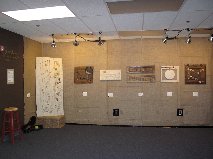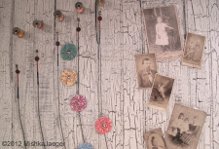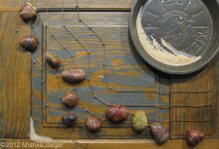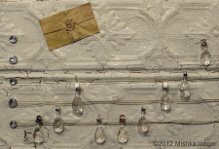
I’ve already introduced Mishka Jaeger to you, using her lovely space at ArtOMatic as an example of a good display that engages all the senses. But I want to give you a more in depth look at Mishka and her work which you can fidn on the 11th floor, just behind the service elevator in space 262.
While Mishka has been attending ArtOMatics since 2002, this is only her second time as a participating artist because it took her a while to figure out what she wanted to show and “to get up the nerve to try it”.
“At first I was coming back as a visitor because it’s such a great idea and there is so much art. Even the so-called ‘bad art’ is inspiring. Now that I have participated, I want to come back for multiple reasons. I met a lot of fellow artists last show – really cool and inspiring people. The whole experience is energizing. Plus, it’s a great venue to try out new things where you don’t have to wonder if it will work in a gallery or if anyone will ever see your work!”
This ArtOMatic’s show is actually a continuation of a series that started with her first ArtOMatic called, “The Score is a Work of Art: Bluegrass.” Here is a bit of the story about the origin of this series:
Back in 2002, my musician/artist brother, Harris, and I were wandering around the galleries of Williamsburg, Brooklyn, discussing what really defined the concept

of art when we ran across a canvas with little paper dots sewn onto it. I got a little emphatic and proclaimed that the piece was silly. It was something I could easily do. Harris said, ‘Ok, so why don’t you’ and I responded, ‘Why would I want to sew little pieces of paper on a canvas? There is no meaning in that to me.’ Of course it didn’t occur to me back then that it might have had meaning to the person who did it. Contemporary art and I hadn’t clicked yet, and to this day I still prefer to know the artist’s intentions in order to understand the art rather than infer a meaning for myself that is almost never in step with the artist’s intentions.
Flash forward to 2008. Harris had died that summer and I was cleaning out his apartment in Brooklyn. I came across a score he had arranged for a bluegrass group and in the margin he had written, ‘the score is a work of art.” He was always pithy like that. For years his email signature read, ‘Art is a ruse.’ Anyway, that paper was on my desk when I was sorting through Harris’s work on his computer. I opened a piece of software he had been working on that he called ‘LiveScore.” “LiveScore” takes a bit of explaining in itself, but suffice it to say that it is automatically generated separate parts intended to be streamed to multiple computers and played by live musicians in real time. The “LiveScroe” applet streamed a blank score that had no beginning, no end, and no notes.
All of a sudden, I remembered that ‘stupid’ canvass with the paper dots and it rearranged itself in my head, quite literally, into a score. I created this first piece as the jacket cover for a memorial CD of Harris’s composition work.
When ArtOMatic 2009 was announced, Mishka decided to make more of the visual scores and codify the series. Each of the pieces in The Score is a Work of Art is limited by

three basic building blocks: first, the ‘canvass’ or backdrop of the piece; second, the musical staff lines, which must have no beginning or end, implying that music is infinite, andwhich must pass through the backdrop on both sides rather than visible end; third, something must represent the notes; and finally, when those building blocks are met, Mishka’s intention is for the piece to convey the feeling of the music visually.
In 2009, Mishka used a variety of different songs in different genres, visually portraying as best she could the way each song made her feel. “The second piece I did in this series was also a tribute to Harris. It was based on Bill Monroe’s “Little Cabin on the Hill” which was a song that Harris played. I used some of his and some of my own old violin strings, and a bunch of skeleton keys I found on eBay. I still have this piece in my living room, but two copies of the original made it into my show this year.”
When Mishka went to get wood to make the copies, she found what she thinks is an old cellar door. That gave her the idea to do a complete bluegrass set. She’s been wanting to put this show together for a couple of years, but it took her a while to accomplish that. She harassed all of her musician friends to give her their cast-off strings for the piece. For this year’s Bluegrass series, she used a double concept of each piece representing both a bluegrass song as well as a different instrument in the bluegrass band.
She chose the materials in this collection to convey a homey, rustic, and comfortable feel. “Bluegrass and old time music in their traditional form have a very organic and unpolished sound. I wanted to represent that sound visually, The backdrops of the pieces include weathered wood, antique tin ceiling tile, and an actual banjo drum head that someone gave me.”
The materials of the pieces are nuanced to go along with the music. For example, the Bass piece is about looking forward to heaven and reuniting with loved ones who have passed on, so Mishka used photographs and an old quilt to convey comfort. The Dobro piece is about a river, so river rocks and sand are used in it. The Mandolin “has a bit of a musical joke – doubled staff lines (the mandolin is double-strung). I pictured an immigrant man in an old bar room drinking and dreaming of unrequited love.” Mishka also wanted the whole of the mandolin piece to represent his love as well. For the banjo piece, if someone hadn’t given her a banjo head, she says she would have searched for something similar to suspend in the frame. As the banjo originally came from Africa, she wanted that piece to look a little wild and tribal. Shes notes that piece was also visually influenced slightly by George Crumb, who created visual scores that are, supposedly, playable though “they look very daunting to me!” Crumb’s influence reminded her that staff lines need not be straight.
Although Mishka’s space is wonderful, she notes that a personal visit is needed to get the full feel of it. “Like most collage-type art, it looks better in person and doesn’t photograph very well.” To complete the exhibit, and as a result of feedback from her last ArtOMatic, Mishka added QR codes under each piece. If you have a smart phone, you can listen to the music that influenced the piece via Youtube (something that is not available to those who just read this interview and look at the pictures!).

Where do you feel art is going?
This is an extremely open question. I don’t know, but I hope that art is becoming more accessible. Music is very accessible. We all have our own soundtracks to our lives – music with which we identify emotionally and on an intimate level. You can say the same thing about other performance art and about books, but most visual art is static.
It is difficult to convey motion or a journey through one piece of art. I think because of that, a viewer is required to stand with a piece for a long time and try to get lost in it in order to find any identity with it, and most viewers won’t make that time. I think that may be partly because this sort of behavior has led to the definition of art galleries as stuffy and pretentious, and partly because visual art is often a lot more like modern classical music.
Mishka say that ArtOMatic is a great place to get down and dirty with the art, but that the hugeness of the venue often doesn’t lend itself well to people really connecting with a piece on first glance. “I think I have a lot more to say on this subject, but I’d better go and think it all out a little more first.”
You can find more of Mishka’s work at her website: http://www.mishkajaeger.com.
To read more interviews and see more photographs from ArtOMatic 2012 and earlier ArtOMatics, go here.



2 Comments
You are most welcome!
Thank you for the interview!